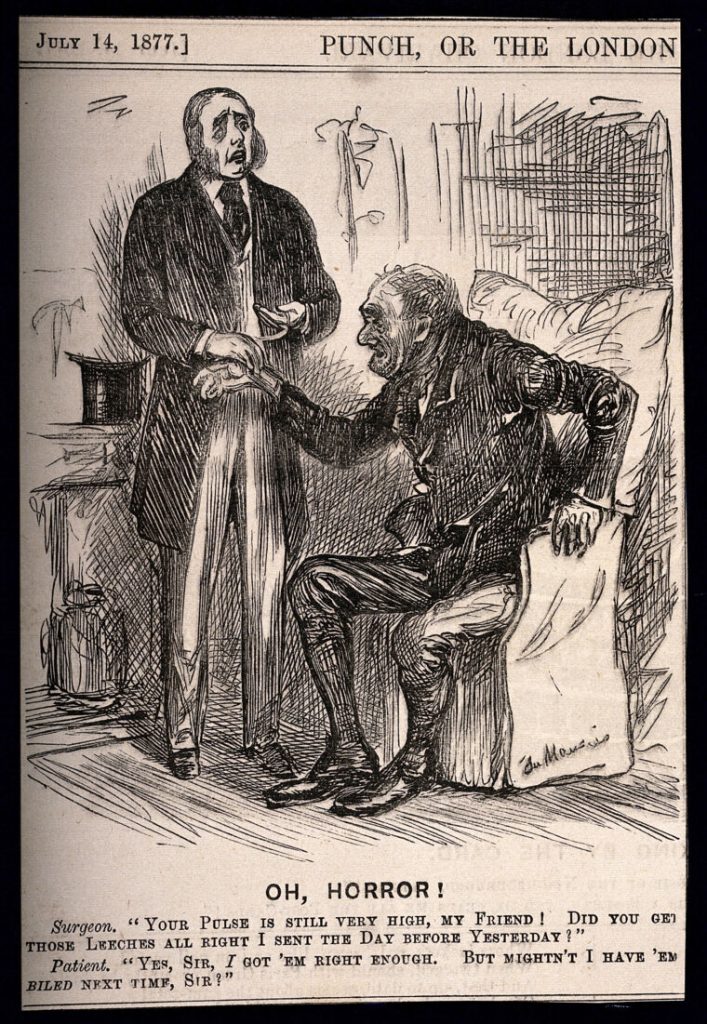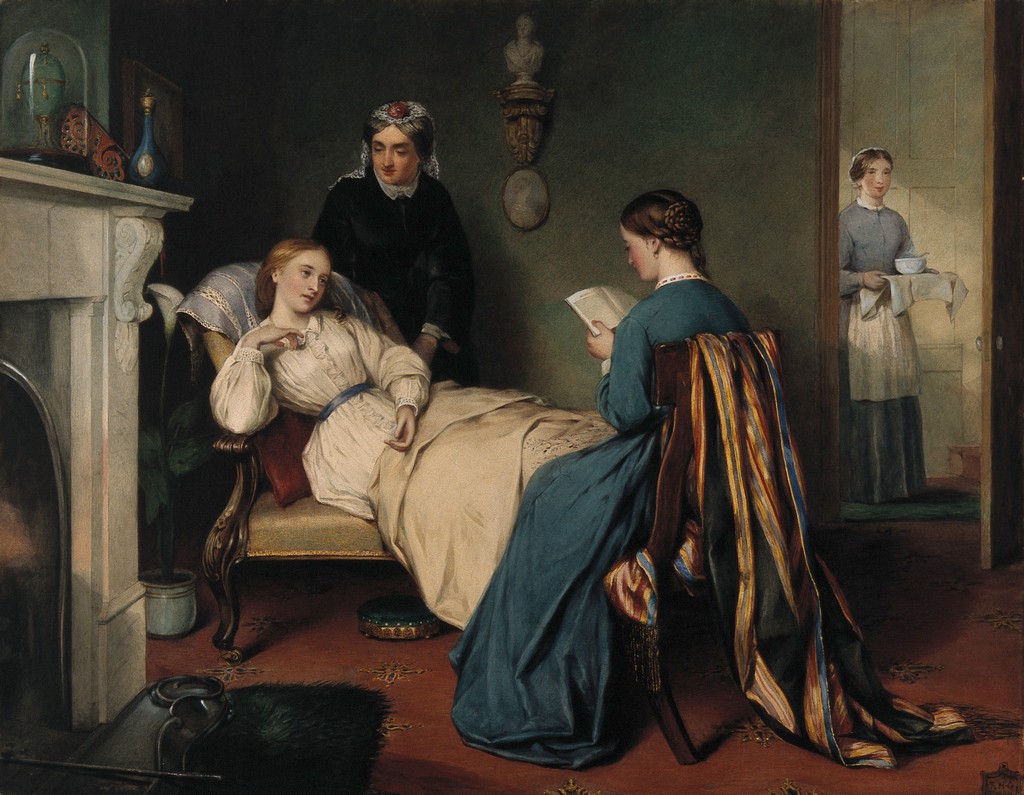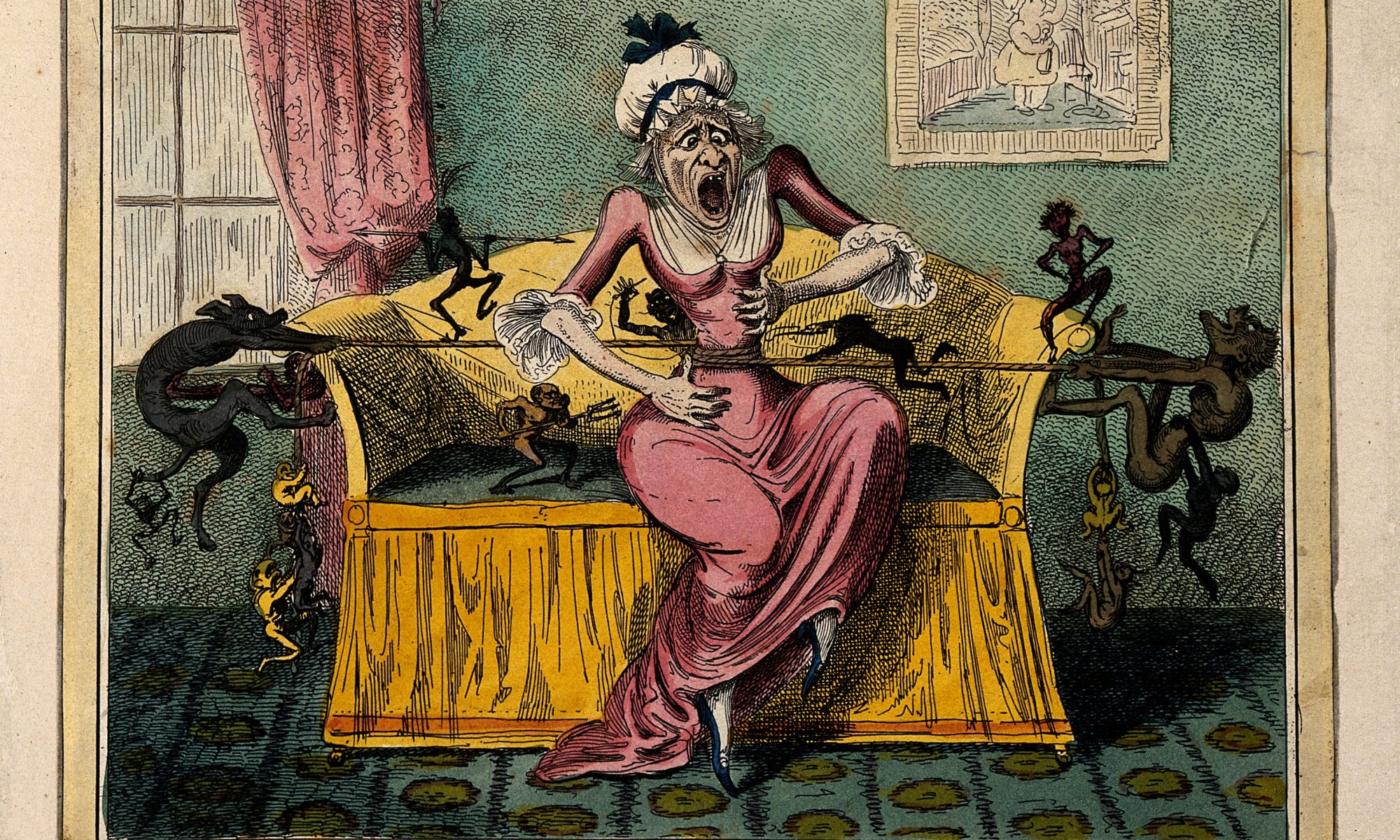Figure 1. A woman suffering the pain of cholic; illustrated by demons tugging on a rope wound around her stomach. Coloured etching by G. Cruikshank, 1819, after Captain F. Marryat. Wellcome Collection.
In 1850, English author Sara Coleridge, who would later die from breast cancer, wrote of her pain in a letter to Aubrey de Vere:
But I must say good-night. This fierce pain clings to me. Oh ! how well can I imagine that all the frightful shapes with which the infernal realms have been peopled, the demons with their prongs and pitchforks, may have been mere brain images, — the shaping forth, by way of diversion and relief, in order to send it off from self, of these sharp pangs and shattering, piercing, nerve tortures ! The vulture of Prometheus is more mental, but Dante’s demons are personifications of Neuralgia and Tic Douloureux, or at least the latter, if they sat for their pictures, would come out just like them. I don’t wonder that Dante begged Virgil to dispense with their company, and would rather wander through the horrid circles without guide, than with those fierce ones.
Coleridge’s description, overflowing with personification and metaphor, may now read as overly dramatic and theatrical, but the literary culture and relationship to pain in nineteenth-century Britain provided a unique environment in which pain sufferers used social and cultural references to make sense of their pain to themselves and to others. The references to classical mythology (in the vulture of Prometheus) as well as religious allegories of Dante’s Inferno, are characteristic of the ways in which many middle- and upper-class women would describe their sufferings. My research is part of a broader project, Experiencing Agony: Pain and Embodiment in the British Atlantic World, 1600-1900, which investigates embodiments of pain and how they changed over time. My own research focuses on how women in nineteenth-century Britain wrote about pain and suffering; the language they used, the words they chose, the comparisons they made. Additionally, I place a particular emphasis on how class influenced the availability of cultural resources accessed by women.
As written in the apophasis research mission, one of the key tenets “…focuses on our (historical or present-day) subjects’ awareness and acknowledgement that something significant is missing or at least difficult to grasp.” The difficulty of grasping pain has been widely acknowledged, and as such was often described through figurative language in nineteenth-century diaries, letters, and autobiographies. Doctors were aware of their patients’ preference so to employ such linguistic aids, and they seemed to be sympathetic to it. Dr Henry Maudsley posited two reasons for his patients’ usage of terms to describe their pain: “These exaggerated descriptions have two reasons of their being: first like such words as absolute, infinite and eternal, they mark the negation of definite conception and are impotences of thought; secondly, they are vain endeavours, by their strong colouring, to excite in the minds of others a proportionate feeling of the really ineffable misery of the strange and bewildering sensations. They are endeavours not to convey ideas, but to express feelings that are in-expressible.”
The language people gave to pain as an emotion operated as the way most gendered emotions did in the nineteenth century: within a specific set of cultural and social scripts that were based on supposed evolutionary science. Patrick D. Kiley (2000, p. 101) explains the ways in which the Enlightenment shaped how people viewed their relationship to pain, and how the natural dichotomies of men and women “were used more easily to explain why the female body was predisposed to an organic composition of ‘delicate [nerve] fibers’ and, as such, was more vulnerable to pain.” However, women being more vulnerable to pain did not mean that they were unable to tolerate it. On the contrary, it was the view of many physicians in the nineteenth century that women were less sensitive to pain than men, with the explanation being that: “The lesser sensibility to pain in woman is an indication of her inferiority to man, as the uncivilized are less sensitive than the civilized, and degenerates less sensitive than normal individuals.” Considering this, it is then unsurprising that the lower classes were believed to not feel pain the same way, if at all, as their betters. However, through patient records and working-class memoirs, although far scarcer than those of middle-class women, we are able to reconstruct to some degree the way pain was described and handled. A “Mrs. S” wrote to The London Hospital Gazette in 1896, recalling that “It is not long since I have got that high and painful belly, only about two months. Sometimes I feel like a hammer knocking in my belly. This week my breasts bite me so, that I cannot describe it…”. The apophatic trait of calling something indescribable, but then describing it, is not lost here.
Why had the nineteenth century brought about a preoccupation with who was entitled to feel pain? For centuries, Christianity had offered a way for people to explain why they were in pain: suffering was a natural part of the human experience, and especially for women in childbirth, was seen as a natural consequence of Eve’s transgression in the Garden of Eden. Religious imagery inspired metaphorical comparisons of pains as devils (as seen in Sara Coleridge’s letters, and Figure 1).
During the second half of the nineteenth century, however, major theological debates and medical advancements (such as the development of anaesthesia in 1848) meant that pain’s necessity was called into question. Pain no longer was an inevitability. Although anaesthesia was without comparison in its ability to prevent suffering, it also brought about a new fear of pain – this, in turn, changed the way women viewed their relationship with pain. During this time, the medical profession also underwent a complete transformation, in which patients were now judged according only to physical lesions and doctors no longer acted based on recommendations of the patient. A transformation of power began to develop based on medical terminology and what Foucault termed “the medical gaze.”

One of the aims of the Apophasis Initiative is to examine the connection between an experience that is unable to be known and the accompanying paradoxes. Pain is full of such paradoxes – it is simultaneously unknowable yet acknowledged, individual yet public, and indescribable yet imbued with countless metaphors. The apophatic element of acknowledging the ineffable nature of pain was also something that nineteenth century writers were familiar with themselves; an article in the British Medical Journal from 1867 mused that, “Strange to say, although pain is man’s melancholy birthright, he scarcely knows what it is: attempts to define it end in vague assertions or tautological phrases; and, as no means of measuring it are known, we cannot in any way render it tangible, tabulate its variations, or train our students to a proper estimate of its relative importance.”
One of the primary characteristics of a pain event, especially physical pain events, is that it is expressed through bodily and facial contortions. Naturally, this poses a problem when reading sources that have described pain events, as the physicality is taken away and reinterpreted into a written medium. Moreover, reading texts looking for expressions and embodiments of pain is by nature reliant upon a degree of reconstruction by the historian, part of which is to “read between the lines” to glean how pain was experienced by the authors. Whilst the nature of pain has been debated constantly by scholars, the beginning stages of my research focus less on the question of if pain operates outside of language, and instead on what the language used can tell us about the place pain occupied in nineteenth-century British society. By acknowledging the slipperiness of such an emotion, we can accept pain as inhabiting the liminal space between description and embodiment, thus contributing to the history of experiences.

Clarice Säävälä (clarice.saavala@helsinki.fi) is a doctoral researcher in the Academy of Finland-funded project called “Experiencing Agony: Pain and Embodiment in the British Atlantic World, 1600–1900,” at the University of Helsinki. (https://blogs.helsinki.fi/experiencingagony/)
Works cited
- Coleridge, Sara and Edith Coleridge. Memoir and Letters of Sara Coleridge. London: H.S. King, 1875. http://archive.org/details/memoirlettersofs00coleuoft. 366. (Letter from August 6, 1850).
- Kiley, Patrick D. Making sense of pain: Reading the sensible body of late eighteenth-and early nineteenth-century France. Perdue University: PhD Dissertation, 2000, p. 101.
- Maudsley, Henry. A Pathology of Mind: A Study of its Distempers, Deformities and Disorders. London: Julian Friendmann Publishers, 1895, p. 172.
- Sieveking, Edward H. “Observations on the Etiology of Pain,” British Medical Journal 1:319 (1867) p. 131.
- “Women’s Sensibility to Pain,” The Dental Register 51:3 (1897) p. 151.

